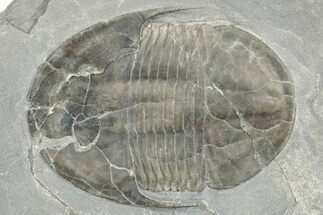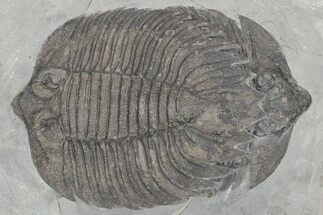This Specimen has been sold.
1.66" Asaphiscus Trilobite Molt - Wheeler Shale, Utah
This is a 1.66" long Asaphiscus wheeleri trilobite from the famous Wheeler Shale of Utah. While the quarries are well known for preserving the more common Elrathia trilobites on nodules, most Asaphiscus are found in the shale rock.
Asaphiscus wheeleri is a Cambrian carnivore that patrolled the offshore shelves, basins, and slopes of a warm equatorial ocean. Asaphiscus is representative of primitive trilobites belonging to the order of relatively large, ancient arthropods, Ptychopariida. Unlike some other Ptychoparids, Asaphiscus has eyes, making it a formidable predator. This extra visual sense would have adapted it well to hunting the Cambrian seas freshly teeming with diversity.
This trilobite hunted the Cambrian oceans from 513 to about 498.5 million years ago. It lived during a great evolutionary arms race at a time where the ocean was deepening and sediments were deposited in a step-wise fashion toward shore. Where Asaphiscus wheeleri lived, the ocean was continually invading into the Laurentia craton, a seemingly barren continental core of North America. In the sea, higher life was abundant and clawing for advantage.
Asaphiscus had the tough armor of the arthropod carapace to protect itself from things lurking in the basin clay. However, it was likely not a lurker and is described as a fast swimmer. It has a characteristic pygidium with a flat border: it shared this adaptation with many other trilobites of this time and environment. One can imagine the purpose for this trait: for protection when the trilobite enrolled like a ball, or for streamlined speed to chase down prey?
These ancient carnivores are found in the Wheeler Shale and Marjum Formations of western Utah. The Wheeler Shale, a remnant of an ancient embayment where the ocean intruded into Utah, is perched in the strikingly arid and steep terrain of the House Range. An oasis among the scrublands, the cold springs that pop from the region's fossiliferous limestones are appreciated by fossil hunters.
Size ranges for Asaphiscus are half an inch to over 3 inches, but typically 1-2 inches. Like modern day lobsters, trilobites molted as they grew, shedding their exoskeletons. About 80 percent of of the specimens collected in the Wheeler Shale tend to be molts. Molts are identifiable because they are missing thee "free cheeks" on the side of their heads. They are collected in the same quarries as the prolific Elrathia kingii but are less common and, due to their thinner shell, less likely to survive intact.
This trilobite hunted the Cambrian oceans from 513 to about 498.5 million years ago. It lived during a great evolutionary arms race at a time where the ocean was deepening and sediments were deposited in a step-wise fashion toward shore. Where Asaphiscus wheeleri lived, the ocean was continually invading into the Laurentia craton, a seemingly barren continental core of North America. In the sea, higher life was abundant and clawing for advantage.
Asaphiscus had the tough armor of the arthropod carapace to protect itself from things lurking in the basin clay. However, it was likely not a lurker and is described as a fast swimmer. It has a characteristic pygidium with a flat border: it shared this adaptation with many other trilobites of this time and environment. One can imagine the purpose for this trait: for protection when the trilobite enrolled like a ball, or for streamlined speed to chase down prey?
These ancient carnivores are found in the Wheeler Shale and Marjum Formations of western Utah. The Wheeler Shale, a remnant of an ancient embayment where the ocean intruded into Utah, is perched in the strikingly arid and steep terrain of the House Range. An oasis among the scrublands, the cold springs that pop from the region's fossiliferous limestones are appreciated by fossil hunters.
Size ranges for Asaphiscus are half an inch to over 3 inches, but typically 1-2 inches. Like modern day lobsters, trilobites molted as they grew, shedding their exoskeletons. About 80 percent of of the specimens collected in the Wheeler Shale tend to be molts. Molts are identifiable because they are missing thee "free cheeks" on the side of their heads. They are collected in the same quarries as the prolific Elrathia kingii but are less common and, due to their thinner shell, less likely to survive intact.
SPECIES
Asaphiscus wheeleri
LOCATION
Antelope Springs, House Range, Utah
FORMATION
Wheeler Shale
SIZE
1.66" long on 4.5 x 4.5" rock
CATEGORY
SUB CATEGORY
ITEM
#97167
We guarantee the authenticity of all of our specimens.
 Reviews
Reviews











